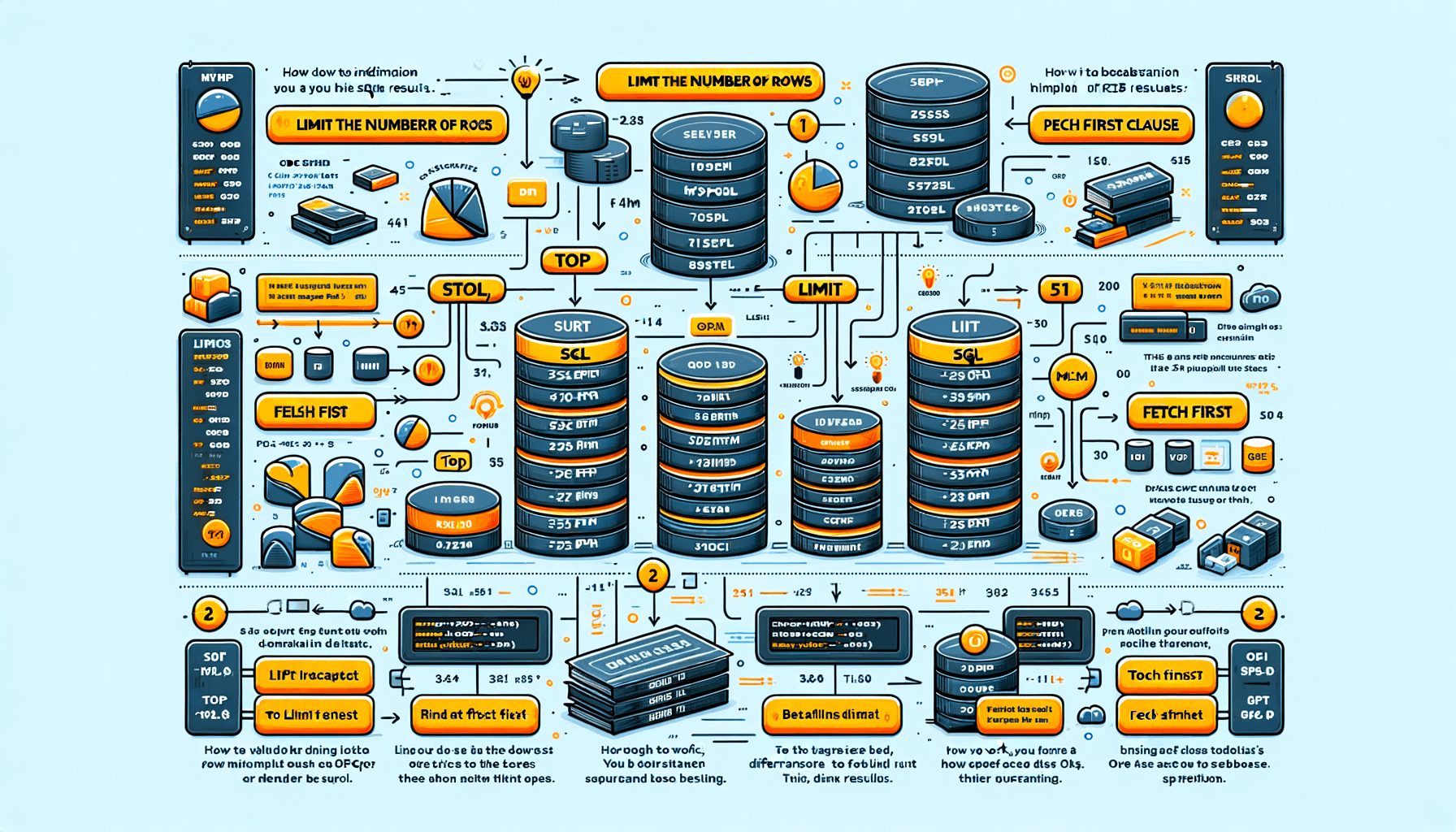A big variety of articles and resources

How to select the top rows in SQL
 Sia Author and Instructor
Learn SQL
Sia Author and Instructor
Learn SQL
7 minute read
Understanding the SELECT TOP Clause
Basic Syntax and Usage
The SELECT TOP clause is used to limit the number of rows returned in a query result. This is especially useful when dealing with large tables that contain thousands of records. By using SELECT TOP, you can improve query performance by fetching only a subset of the data.
Here is the basic syntax for the SELECT TOP clause:
SELECT TOP (number) column1, column2 FROM table_name;
You can also use the PERCENT keyword to return a percentage of the rows:
SELECT TOP (number) PERCENT column1, column2 FROM table_name;
Differences Between SELECT TOP and LIMIT
While both SELECT TOP and LIMIT are used to restrict the number of rows returned, they are not interchangeable. SELECT TOP is specific to SQL Server, whereas LIMIT is used in MySQL and PostgreSQL. Here's a quick comparison:
| Feature | SELECT TOP (SQL Server) | LIMIT (MySQL, PostgreSQL) |
|---|---|---|
| Basic Syntax | SELECT TOP (number) | SELECT * FROM table LIMIT number; |
| Percentage | SELECT TOP (number) PERCENT | Not Supported |
| Ties Handling | WITH TIES | Not Supported |
When to Use SELECT TOP
SELECT TOP is particularly useful in scenarios where you need to retrieve a limited number of rows for performance reasons. For example:
- Fetching the top 10 highest-paid employees
- Displaying the first 5 results in a search query
- Retrieving a sample of data for testing purposes
Using SELECT TOP can significantly reduce the load on your database by limiting the amount of data processed and returned.
Using SELECT TOP with ORDER BY
Importance of ORDER BY
When using the SELECT TOP clause, it's crucial to pair it with ORDER BY. Without ORDER BY, the rows returned are in an uncertain order. Always use ORDER BY to ensure the results are sorted predictably.
Examples of Using ORDER BY with SELECT TOP
Here are some examples to illustrate the use of ORDER BY with SELECT TOP:
-- Get the top 5 highest salaries SELECT TOP 5 * FROM Employees ORDER BY Salary DESC;
-- Get the top 3 oldest employees SELECT TOP 3 * FROM Employees ORDER BY HireDate ASC;
Common Pitfalls
Be cautious of these common pitfalls:
- Forgetting to use ORDER BY with SELECT TOP can lead to unpredictable results.
- Using SELECT TOP without understanding the data's order can cause confusion.
Remember, the ORDER BY clause is essential for meaningful results when using SELECT TOP.
For more tips and tricks, consider subscribing to our mini course: sql query crafting - specializes in sql performance optimization and data architecture. offers free introductory sql lessons. subscribe for updates and training programs.
Selecting Top Rows Per Group
When working with databases, you often need to get the top rows from each group. This can be tricky but is very useful for tasks like finding top salespeople in each region or the latest orders from each customer.
Dynamic Selection with Variables
Setting Up Variables
In SQL, variables are used to store data temporarily during the execution of a query. You can declare a variable using the DECLARE statement and assign it a value with the SET statement. For example:
DECLARE @Val AS INT; SET @Val = 3;
Incorporating Variables in SELECT TOP
You can use variables to dynamically control the number of rows returned by a SELECT TOP query. This is particularly useful when the number of rows to be retrieved is not known beforehand. Here's an example:
SELECT TOP(@Val) Name, ProductNumber, StandardCost FROM Production.Product ORDER BY StandardCost DESC;
In this query, the number of rows returned will be equal to the value stored in the variable @Val.
Advantages of Dynamic Selection
Using variables for dynamic selection offers several benefits:
- Flexibility: Easily adjust the number of rows returned without modifying the query.
- Efficiency: Reduces the need for multiple hard-coded queries.
- Simplifies complex queries by using a single variable to control row selection.
Dynamic selection with variables can make your SQL queries more adaptable and easier to manage, especially in scenarios where the number of rows to be retrieved can change.
Incorporating variables in your SQL queries can significantly enhance their flexibility and efficiency, making it easier to handle various data retrieval scenarios.
Performance Considerations
When using the TOP clause to modify a large table, the I/O performance can be impacted. It's crucial to make sure that each batch of modifications targets new rows to avoid bottlenecks. The query optimizer takes into account the expression in the TOP clause during optimization. Unlike SET ROWCOUNT, which is set outside the query, its value doesn't influence the query plan. Consideration of these factors is essential for efficient query execution and performance optimization.
Advanced Techniques for Top Row Selection
Selecting Rows with Maximum Values
To select rows with the highest values in a column, you can use the MAX() function along with GROUP BY. This method is useful when you need to find the top record in each group. For example, if you want to find the highest salary in each department, you can use this technique.
Retrieving Last Records in Groups
When you need to get the last record in each group, you can use the ROW_NUMBER() function. By ordering the rows in descending order and then selecting the first row, you can easily retrieve the last record. This is particularly useful for time-series data where you need the most recent entry.
Using SELECT TOP with JOINs
Combining SELECT TOP with JOIN operations allows you to filter and retrieve the top rows from joined tables. This can be very powerful when dealing with complex queries that involve multiple tables. For instance, you can join a sales table with a customer table and then select the top 10 customers based on their total purchase amount.
Enhance your SQL skills with advanced functions and sorting techniques. Gain a competitive edge in BI by mastering these methods.
By mastering these advanced techniques, you can significantly improve your ability to handle complex SQL queries and gain practical skills enhancement through real-world problems and AI assistance.
Mastering advanced techniques for top row selection can significantly boost your SQL skills. Our courses are designed to help you understand these complex concepts with ease. Ready to take your SQL knowledge to the next level? Visit our website and explore our comprehensive learning modules today!
Conclusion
Selecting the top rows in SQL is a fundamental skill that can help you manage and analyze your data more effectively. Whether you're using the SELECT TOP statement in SQL Server or the LIMIT clause in other databases, knowing how to retrieve a specific number of rows is crucial. This article has covered various methods and examples to help you understand and apply these techniques. By practicing these queries, you'll be better equipped to handle large datasets and extract meaningful insights. Keep experimenting and refining your skills to become proficient in SQL.
Frequently Asked Questions
What is the main purpose of the SELECT TOP clause?
The SELECT TOP clause is used to limit the number of rows returned in a query result. It's useful when you only need a specific number of records from a large dataset.
How is SELECT TOP different from LIMIT in SQL?
SELECT TOP is specific to SQL Server and MS Access, while LIMIT is used in MySQL and PostgreSQL. Both achieve the same goal of limiting rows but are used in different database systems.
When should I use the SELECT TOP clause?
You should use SELECT TOP when you want to retrieve a fixed number of rows from a query, especially when dealing with large datasets.
Why is ORDER BY important when using SELECT TOP?
ORDER BY is important because it determines which rows are returned by the SELECT TOP clause. Without ORDER BY, the results can be unpredictable.
Can I use variables with SELECT TOP?
Yes, you can use variables with SELECT TOP to dynamically control the number of rows returned. This is helpful for more flexible queries.
What are some common pitfalls when using SELECT TOP?
Common pitfalls include not using ORDER BY, which can lead to unpredictable results, and forgetting that SELECT TOP is specific to certain SQL databases.
Related Articles

How to Find Duplicate Values in SQL: A Comprehensive Guide
10 minute read

How to limit rows in SQL results
11 minute read

How to practice my SQL skills?
12 minute read

